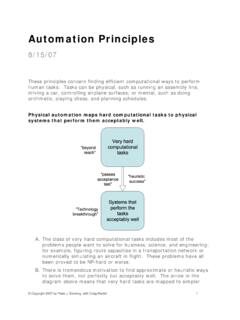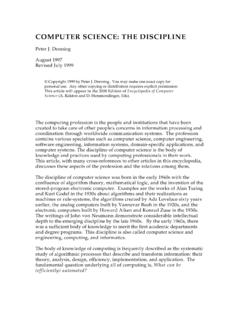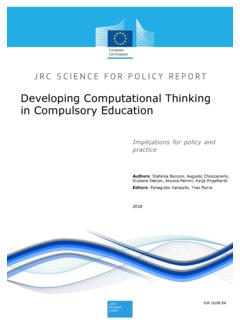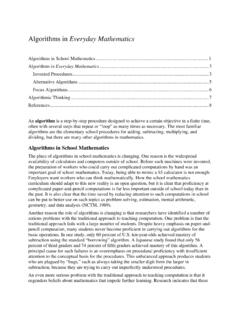Transcription of The Long Quest for Computational Thinking
1 The long Quest for Computational ThinkingMatti TedreStockholm University, DSV Kista, J. DenningNaval Postgraduate SchoolMonterey, CA, Thinking (CT) is a popular phrase that refersto a collection of Computational ideas and habits of mindthat people in computing disciplines acquire through theirwork in designing programs, software, simulations, and com-putations performed by machinery. Recently a computa-tional Thinking for K 12 movement has spawned initiativesacross the education sector, and educational reforms are un-der way in many countries. However, modern CT initia-tives should be well aware of the broad and deep historyof Computational Thinking , or risk repeating already refutedclaims, past mistakes, and already solved problems, or los-ing some of the richest and most ambitious ideas in paper presents an overview of three important histor-ical currents from which CT has developed.
2 Evolution ofcomputing s disciplinary ways of Thinking and practicing,educational research and efforts in computing, and emer-gence of Computational science and digitalization of paper examines a number of threats to CT initiatives:lack of ambition, dogmatism, knowing versus doing, exag-gerated claims, narrow views of computing, overemphasison formulation, and lost sight of Computational Concepts Social and professional topics History of comput-ing; Computational Thinking ;KeywordsComputer science education; Computational Thinking ; CSER; Computational ideas; History of Computational Thinking ;Disciplinary ways of Thinking and practicing1.
3 INTRODUCTIONC omputational Thinking (CT) has become the subject ofworldwide attention in recent years as part of multiple effortsto bring computer science into all K 12 schools. The leadersPermission to make digital or hard copies of all or part of this work for personal orclassroom use is granted without fee provided that copies are not made or distributedfor profit or commercial advantage and that copies bear this notice and the full citationon the first page. Copyrights for components of this work owned by others than theauthor(s) must be honored. Abstracting with credit is permitted.
4 To copy otherwise, orrepublish, to post on servers or to redistribute to lists, requires prior specific permissionand/or a fee. Request permissions from Calling 2016, November 24 - 27, 2016, Koli, Finlandc 2016 Copyright held by the owner/author(s). Publication rights licensed to 978-1-4503-4770-9/16/11.. $ : the movement have proposed definitions, a body of knowl-edge, and assessment methods for CT [1, 2]. They have someimpressive achievements, including the training of 10,000 CSteachers in the US, a new Advanced Placement (AP) pro-gram, and a set of CS principles courses at universities thatreceive graduates of the new AP program.
5 CSTA (computerscience teachers association), , and havebeen working on detailed curriculum guidelines and obtain-ing political support at the US federal and state level to pushcomputer science into all K 12 schools. Similar initiativeshave quickly emerged in other countries, too [3, 4].The current movement began in 2006 with an essay byJeannette Wing [5]. Her idea was that everyone would ben-efit from learning to think like a computer scientist [6]. How-ever, the movement has been criticized for vagueness, am-biguous definitions and visions of CT, and arrogance [4], aswell as for bold, unsubstantiated claims about the universalbenefit of CT [3].
6 The computing education community hasfound it hard to find a consensus on definition of CT [4].The multiple CT visions, although inspiring and ambitious,do not agree on what exactly should be taught about CT,how to assess whether students have learned CT, and whoare the main beneficiaries of purpose here is to deepen and broaden discussionsabout CT by taking a careful look at the long and rich his-tory of CT as well as its ambitious visions over the s definition of CT stands out for its exceptional clarity: Computational Thinking is the thought processes involvedin formulating problems so their solutions can be representedas Computational steps and algorithms [7].
7 Aho was re-flecting an idea about thought processes in computing thathad been in play since the 1950s. Many early pioneers re-garded Computational , algorithmic, or procedural thinkingas an important skill set for those who design and implementcomputations. The new CT movement aimed to include alsothose who use Computational tools and those who engage instep-by-step procedures [5]. The attempt to broaden the CTaudience moved into uncharted territory, where there is lesscertainty that tool users and procedure followers need CTor benefit from survey describes the historical development of CTand the intellectual ideas that drove its development.
8 In theprocess we will examine various claims about CT and willconclude some of them are see three reasons to review CT and its claims from ahistorical perspective. Firstly, understanding the long his-tory of CT is a matter of academic rigor, standing on theshoulders of giants. When researchers do their homework120 Tedre, Matti; Denning, Peter J. (2016) The long Quest for Computational Thinking . Proceedings of the 16th Koli Calling Conference on Computing Education Research, November 24-27, 2016, Koli, Finland: pp. , they know what previous generations of scientists havetried and done, and where they have succeeded and avoid reinventing the wheel by acknowledging pre-decessors who built the foundations on which the currentgeneration of researchers is now working.
9 In this paper wewill suggest that a lack of knowledge about CT s long andrich history may lead to weaker and less ambitious versionsof CT than we have seen in the past, causing CT to diminish,not , strong unsubstantiated claims create expecta-tions about CT that cannot be fulfilled. We will see thatsome bold claims of CT have repeatedly been made andrefuted over several decades. An example is the claim ofautomatic skill transfer from CT to different knowledge do-mains, which was debunked in the 1980s [8] but which wasrepeated so persistently that even a recent 2015 book had toexplicitly repeat the extensive critique of that claim aboutCT [3, pp.]
10 27 29, 39 40]. Exaggerated claims about CTserve no one for eventually, when CT cannot deliver onsuch claims, there will be many disillusioned educators andconsumers of education, and computer science will be seenas an over-seller of CT. CT is powerful enough without ex-aggerated , the direct beneficiaries of CT engineering, sci-ence, and design are deeply historical. In contrast, the be-havior of machines and information transforming processesstudied in the Computational sciences and engineering areby nature context free: the machine is supposed to behavein a certain well defined way irrespective of where or whenit is used.











